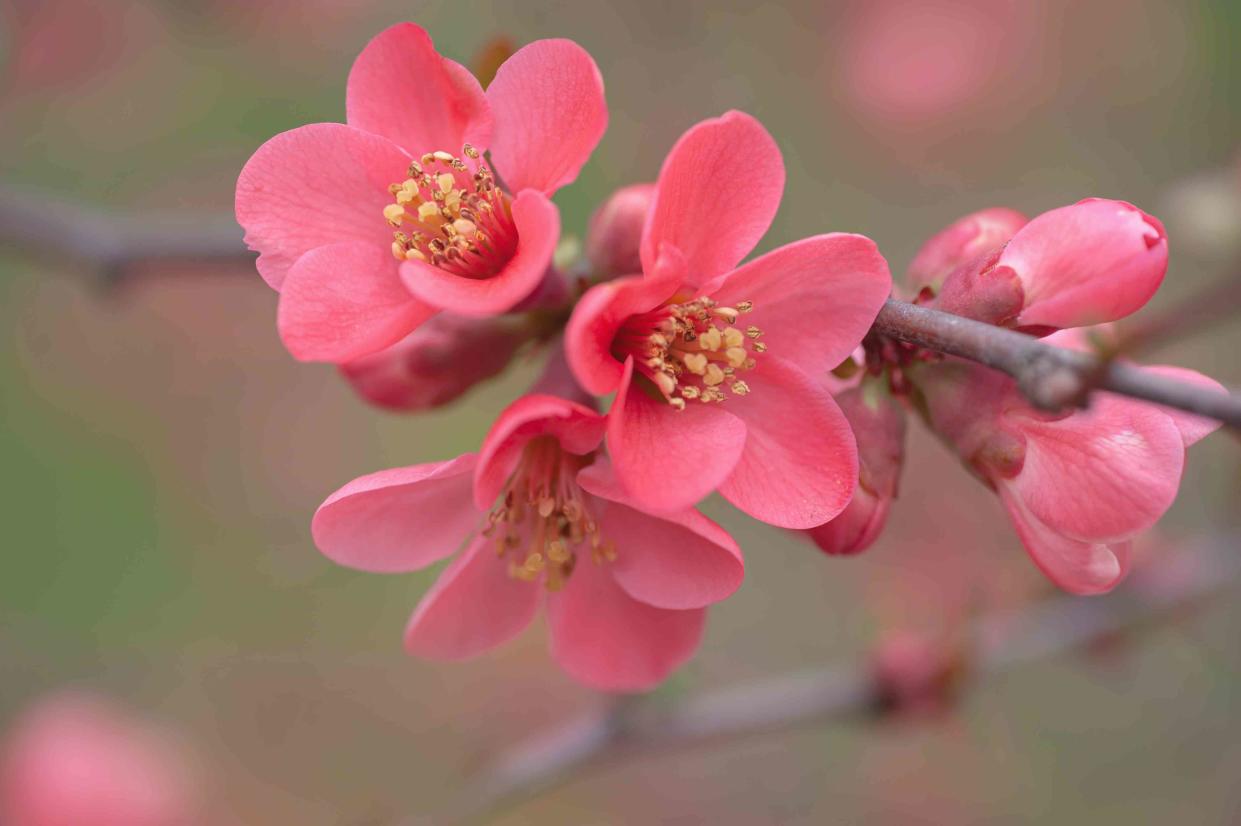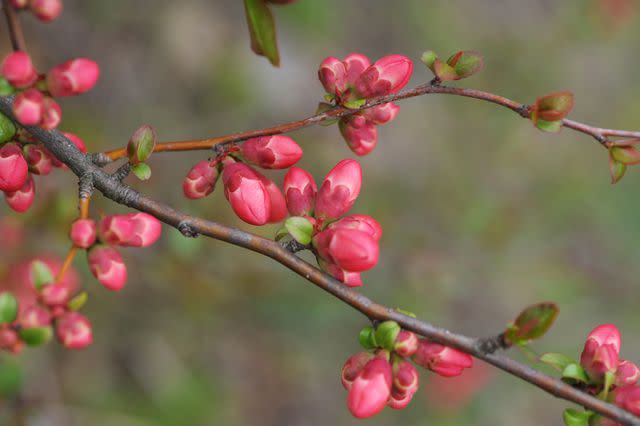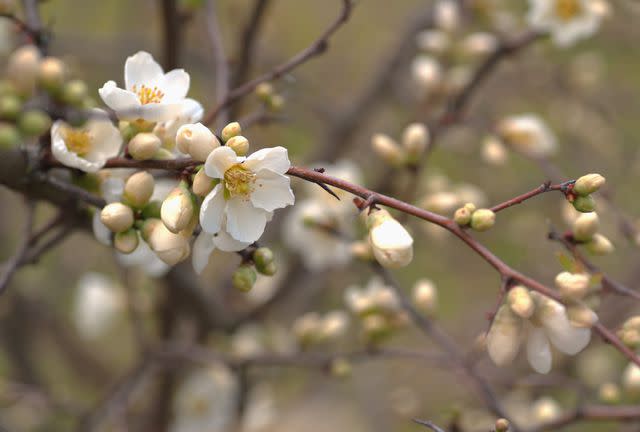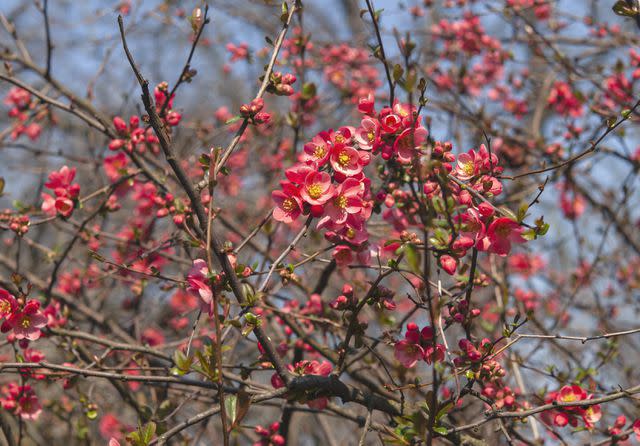How to Grow and Care for Japanese Quince

The Spruce / Evgeniya Vlasova
Japanese quince, also commonly known as japonica, is an ornamental flowering shrub with showy spring flowers and tart yellow fruit, known as quince, that appears in the fall. It is also favored for use as a bonsai plant. Japanese quince grows well in a wide range of conditions but thrives best in full sun and soil that's more on the acidic side. Read on for our care and growing guide.
Common Name | Japanese quince, japonica, dwarf quince, Maule's quince, ornamental Japanese flowering quince |
Botanical Name | Chaenomeles japonica |
Family | Rosaceae |
Plant Type | Shrub |
Mature Size | 2-3 ft. tall, 3-6 ft. wide |
Sun Exposure | Full, partial |
Soil Type | Moist, well-draining, clay, loamy, sandy |
Soil pH | Acidic |
Bloom Time | Spring |
Flower Color | Orange, pink, red, burgundy, white |
Hardiness Zones | 5-9 (USDA) |
Native Areas | Asia |
Japanese Quince Care
Here are the main care requirements for growing Japanese quince:
Plant in full sun for best results but the plant will tolerate partial shade.
Water well, about 1 inch a week, especially in dry periods.
Train Japanese quince to grow on a trellis or espaliered, as an option to growing it in garden borders or as low hedges or barrier plants.

The Spruce / Evgeniya Vlasova

The Spruce / Evgeniya Vlasova

The Spruce / Evgeniya Vlasova

The Spruce / Evgeniya Vlasova
Light
Japanese quince will tolerate partial shade but will produce the most blossoms if planted in full sun.
Soil
Japanese quince is adaptable to various types of soil. However, it may do best in average, loamy, moist, and well-drained soil. Once the shrub is established, it can tolerate some dryness.
Water
Give shrubs 1 inch of water per week through a combination of rainfall and irrigation. Shrubs tolerate a wide range of conditions and are somewhat drought resistant. During dry periods, water regularly, taking care to avoid overwatering.
Temperature and Humidity
An established Japanese quince tolerates a variety of temperatures and levels of humidity. This species is cold-hardy and can withstand infrequent temperatures down to about -15 to -25 degrees Fahrenheit.
Fertilizer
Like any shrub, Japanese quince will benefit from the annual application of an all-purpose balanced fertilizer in early spring, but it is not required. For the amount to use, follow product label instructions.
Types of Japanese Quince
Chaenomeles japonica 'Atsuya Hamada': The shrub grows to 8 to 10 feet tall with deep red blooms.
Chaenomeles japonica 'Orange Delight': This shrub has a smaller stature but offers a burst of stunning coral-orange flowers.
Chaenomeles japonica 'Chojuraku': Double flowers bloom in orange-apricot and may reach 4 to 5 feet in height and width in 10 years.
Pruning
Pruning is not required unless the shrub is being espaliered. Avoid heavy pruning, as flowering takes place on old growth. After spring blossoming is completed around April or May, prune side shoots to five or six leaves. Remove any dead, diseased, or damaged branches at the same time. Never prune branches while they are flowering. Japanese quince will produce suckers, which should be removed promptly.
Propagating Japanese Quince
Japanese quince can be propagated by softwood cuttings. Take these steps in June and July when the shrub is in growth mode.
Take a cutting of a semi-mature shoot that is about 6 to 8 inches long. Make sure the middle part is firm and the base is almost woody.
Remove lower leaves but keep a pair of leaves at the top.
Dip the lower part of the cutting in rooting hormone.
Add and moisten peat and perlite potting mix in a small container and insert the cutting.
Cover the pot in a loose, clear plastic bag and place the pot in bright, but indirect light.
Immediately mist the cutting.
The cutting should become rooted in about four weeks.
Plant the cutting in its permanent position outdoors in about another four weeks before any threats of frost and water consistently.
How to Grow Japanese Quince From Seed
Like most shrubs, you can easily grow Japanese quince from seeds. However for the seeds to germinate properly, they need to go through the stratification process or a freeze-and-thaw cycle. Take these steps:
Harvest seeds from the quince fruits in the fall.
Separate seeds from the pulp. Wash the seeds in water, then drain and dry them on a paper towel for 24 hours in a cool dark area.
Mimic the winter cold by putting the dry seeds in a clear plastic bag with clean sand or sphagnum moss. Put the bag in the refrigerator for 60 to 90 days.
Remove seeds from the bag and the mix, and plant in regular potting mix. Water the soil and cover with loose clear plastic until germination occurs.
Transplant seedlings into separate containers when you see two sets of true leaves develop.
Keep the soil moist but not too damp or soggy.
When seedlings are 12 inches tall, transplant outdoors in the springtime to their permanent home.
Overwintering
Protect young Japanese quince shrubs with a trunk covering such as a cylinder of metal hardware cloth that is placed several inches into the soil to prevent the burrowing of pests. In cold northern climates, mulch the root zone of young Japanese quince shrubs.
Common Pests & Plant Diseases
New growth on a Japanese quince shrub is susceptible to aphids. Eliminate a light infestation using a hard spray of water. Other pests, such as scale and mites, may attack the Japanese quince. Use insecticidal soaps or horticultural oils to handle scale and mite infestations.
Japanese quince is prone to fungal leaf spot, particularly during a springtime that is wetter than usual. This issue can cause defoliation. The best prevention is to make sure the shrub has good air circulation and adequate sunlight streaming into the plant. Fungicides applied before the growing season can help. Remove infected leaves and other parts of the shrub.
How to Get Japanese Quince to Bloom
Bloom Months
Bloom time for Japanese quince can be a bit erratic. However, in March you will likely see the blossoms burst forth from buds that have developed on the bare branches during the late winter depending on the region.
What do Japanese Quince Flowers Look and Smell Like?
The Japanese quince shrub's flowers are composed of five petals with white stamens in the center. They are typically a brilliant orange-red but may be pink or even creamy white. It is not until after blossoming that new leaves are produced. The fragrant flowers and fruit, known as quince, attract birds, bees, and butterflies.
How to Encourage More Blooms
Make sure the soil is more acidic or neutral. The plant will not bloom well in alkaline soil. The shrub prefers full sun for more prolific blooms.
In winter, branches with formed flower buds may be cut and taken indoors to force blooming. This makes for an attractive winter floral arrangement.
Common Problems With Japanese Quince
Once established, Japanese quince can be relatively easy to grow with low-maintenance needs. However, no shrub is immune to issues, including the following:
No Blooms
If a Japanese quince does not bloom, it could be that the buds were damaged due to early spring frosts. Flowers should return the following year. Or, bud-bearing branches may have been accidently pruned before the blooming season.
Yellowing Leaves
Chlorosis (yellowing of the foliage) can occur in high pH (alkaline) soils. Fix this issue with a feeding of acidifying fertilizer or elemental sulfur to lower the soil pH. Yellowing leaves that are wilting and dropping can also indicate overwatering.
Frequently Asked Questions
Are Japanese quince fruits edible?
The fruits are edible, whether they are raw or cooked. But they are tough, sour, and bitter when eaten raw. Fruits can be cooked—many people use them to make jam—which is best because sugars are released and the taste becomes a combination of fruity, tangy, and floral flavors.
Is Japanese quince a tree?
It is considered a low-growing ornamental flowering shrub that produces tangled thorny branches that are gray-brown. However, Japanese quince (Chaenomeles japonica) is often confused with the quince tree (Cydonia oblonga), which grows about 15 feet tall. Japanese quince is also confused with another shrub called flowering quince (Chaenomeles speciosa), but this shrub grows slightly taller to 10 feet and it is native to China.
How big does a Japanese quince get?
As a species plant, Japanese quince only grows as tall as 3 feet but spreads wider at 6 feet. Some cultivars are larger so consult the plant tags when you purchase your shrub.
Read the original article on The Spruce.

